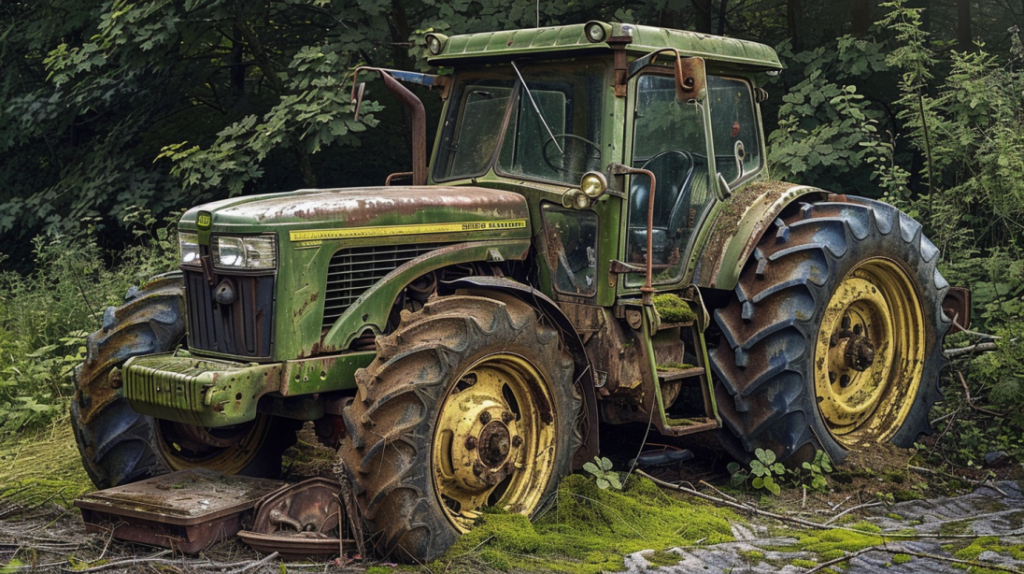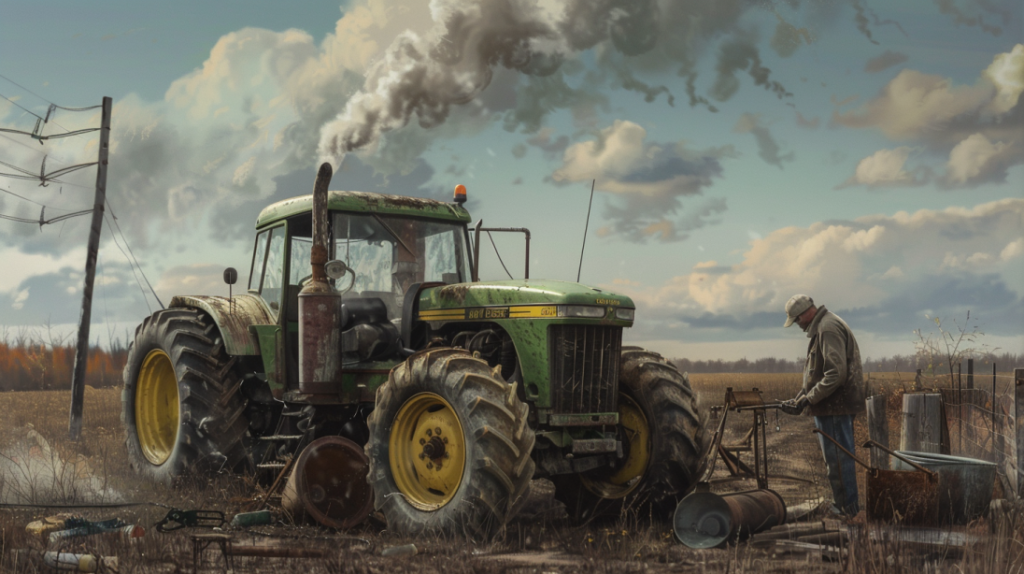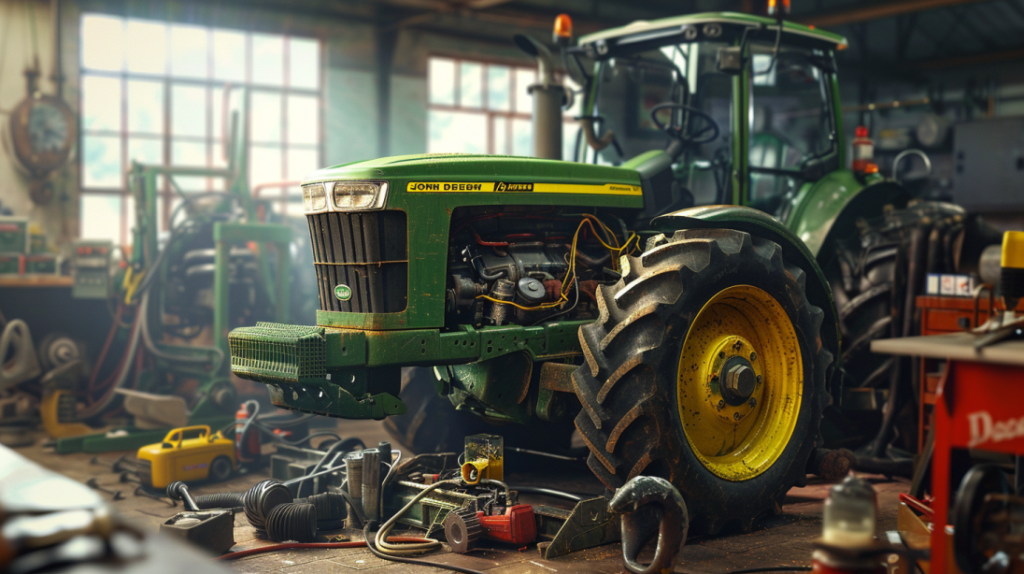If you own a John Deere 2520 tractor, watch out for fuel system hiccups like clogged filters and weak fuel pumps impacting performance. Keep tabs on the hydraulic system for pump wear or leaks that can reduce efficiency. Don’t overlook electrical glitches; check for corrosion on terminals and damaged wiring harnesses. Troubleshoot systematically to find the root cause and refer to the manual for a structured approach. Regular maintenance like inspecting connections and cleaning terminals can stave off potential issues down the road.
Engine Troubles

If you’re experiencing engine troubles with your John Deere 2520, a common issue reported by users is related to fuel system malfunctions. One of the primary reasons for engine problems in the John Deere 2520 is clogged fuel filters. Over time, these filters can accumulate debris and sediment, restricting the flow of fuel to the engine. This can lead to issues such as poor performance, rough idling, and even stalling.
To address this, it’s recommended to regularly inspect and replace the fuel filters according to the manufacturer’s guidelines.
Another common engine-related problem in the John Deere 2520 is a faulty fuel pump. A failing fuel pump can result in inadequate fuel delivery to the engine, causing a range of issues like difficulty starting the tractor, loss of power, and erratic engine performance. If you suspect a faulty fuel pump, it’s important to have it diagnosed and replaced by a qualified technician to ensure optimal engine function.
Hydraulic System Faults
One common issue frequently encountered with the John Deere 2520 is hydraulic system faults, particularly concerning the functionality of the hydraulic pump. If you notice erratic or weak hydraulic system performance, it could be due to a worn-out hydraulic pump. This component is essential for providing the necessary pressure to operate various hydraulic functions on your tractor efficiently.
When facing hydraulic system faults, it’s important to inspect the pump for signs of wear, damage, or leaks. Additionally, check the hydraulic fluid levels and quality as inadequate fluid or contamination can also lead to system malfunctions. In some cases, air may have entered the system, causing issues with hydraulic function.
To address these faults, consider consulting a professional technician to diagnose the problem accurately and perform the necessary repairs. Proper maintenance of the hydraulic system, including regular fluid checks and filter replacements, can help prevent future faults and ensure top performance of your John Deere 2520.
Electrical Issues

Inspect the electrical system of your John Deere 2520 meticulously to identify and address any potential issues promptly. Electrical problems can be frustrating, but with a systematic approach, you can effectively troubleshoot and repair them. Here are key areas to focus on:
- Battery: Check the battery terminals for corrosion or loose connections. Make sure the battery is holding a proper charge to avoid starting issues.
- Wiring: Examine the wiring harness for any signs of wear, fraying, or damage. Faulty wiring can lead to shorts or malfunctions in various components.
- Fuses: Examine all fuses for signs of damage or blown fuses. Faulty fuses can disrupt the electrical flow and cause specific functions to fail.
- Solenoids and Relays: Test the solenoids and relays to confirm they’re functioning correctly. These components play an important role in the operation of various electrical systems on your John Deere 2520.
Troubleshooting Advice
Adopt a systematic approach when troubleshooting electrical issues on your John Deere 2520 to efficiently identify and resolve any underlying problems. Begin by inspecting the wiring harness for any visible signs of damage, such as fraying or exposed wires. Check all connections to confirm they’re secure and free of corrosion.
Utilize a multimeter to test the voltage at various points in the electrical system to pinpoint any irregularities.
If you encounter an issue where certain electrical components aren’t functioning correctly, refer to the technical manual for your John Deere 2520 to locate the specific wiring diagrams and diagnostic procedures. Following the manufacturer’s guidelines meticulously is crucial to avoid causing further damage during troubleshooting.
Consider isolating different sections of the electrical system by disconnecting components and testing them individually. This method can help identify whether the problem lies within a specific component or the overall system.
Remember to exercise caution when working with electrical systems and always disconnect the battery before conducting any troubleshooting to prevent accidents.
Preventative Measures

To prevent future electrical issues on your John Deere 2520, implement regular inspection and maintenance practices. Follow these steps to keep your equipment in top condition:
- Check Wiring Connections:
Regularly inspect all wiring connections for signs of wear, corrosion, or loose connections. Verify all connections are secure and free of damage to prevent electrical problems.
- Clean Battery Terminals:
Clean the battery terminals and cables to prevent corrosion buildup, which can lead to poor electrical connections. Use a mixture of baking soda and water to clean the terminals thoroughly.
- Inspect Fuses and Circuit Breakers:
Check fuses and circuit breakers for any signs of damage or wear. Replace any faulty components immediately to prevent electrical malfunctions.
- Perform Regular System Checks:
Schedule routine system checks to inspect the overall electrical system of your John Deere 2520. Look for any warning signs such as dim lights or sluggish starter motors and address them promptly to avoid larger issues.
Frequently Asked Questions
Can the John Deere 2520 Be Used for Snow Removal?
Yes, the John Deere 2520 can be used for snow removal. Its compact size and powerful engine make it well-suited for clearing snow from driveways, sidewalks, and small to medium-sized areas.
Equipped with a front snowblower or blade attachment, the 2520 can efficiently handle snow removal tasks with ease.
The versatility and reliability of this machine make it a practical choice for tackling winter weather challenges.
What Attachments Are Compatible With the John Deere 2520?
When it comes to attachments for your John Deere 2520, you have a range of options to enhance its functionality. Compatible attachments include front loaders for heavy lifting, backhoes for digging tasks, and mowers for lawn maintenance.
Other popular choices are snow blowers for winter snow removal and tillers for soil preparation. It’s crucial to make sure that any attachments you purchase are specifically designed to fit and work with your John Deere 2520.
How Often Should the Transmission Fluid Be Changed?
For peak performance and to prevent potential issues, change the transmission fluid in your John Deere 2520 every 200 hours of operation.
This routine maintenance task guarantees smooth operation and longevity of your tractor’s transmission system. By following this recommended interval, you can keep your equipment running efficiently and avoid costly repairs down the line.
Is the John Deere 2520 Suitable for Landscaping Jobs?
If you’re considering landscaping tasks, the John Deere 2520 is a solid choice. Its compact size makes it maneuverable in tight spaces, perfect for various landscaping jobs.
Equipped with a capable engine and versatile attachments, this machine can handle tasks like mowing, tilling, and more. Its durability and ease of use make it a reliable option for your landscaping needs.
What Is the Average Lifespan of a John Deere 2520?
When it comes to the average lifespan of a John Deere 2520, you can typically expect it to last around 5,000 to 7,000 hours of operation.
Regular maintenance and timely repairs can help extend its longevity even further, ensuring that your investment in this machine pays off for years to come.
Keep a close eye on wear and tear, address issues promptly, and this robust tractor should serve you well through many landscaping jobs.
Conclusion
To sum up, while the John Deere 2520 is a reliable piece of equipment, it isn’t without its common issues.
One interesting statistic to note is that approximately 30% of reported problems with the 2520 are related to the hydraulic system.
By staying on top of regular maintenance and addressing issues promptly, owners can keep their 2520 running smoothly and efficiently for years to come.

Leave a Reply